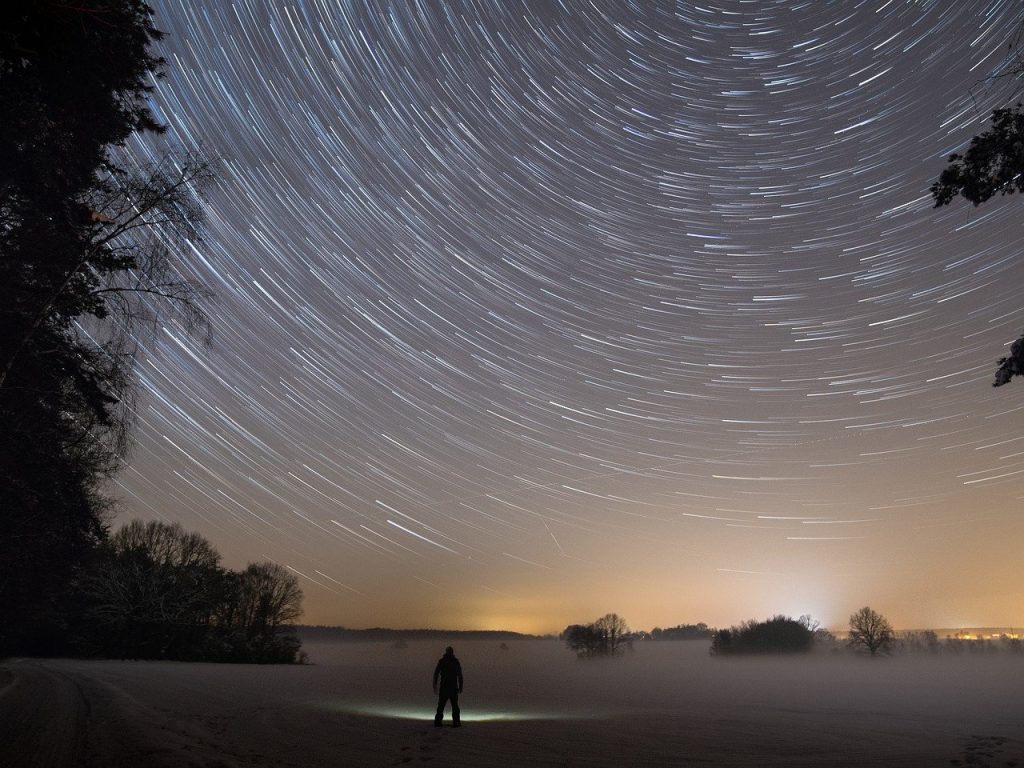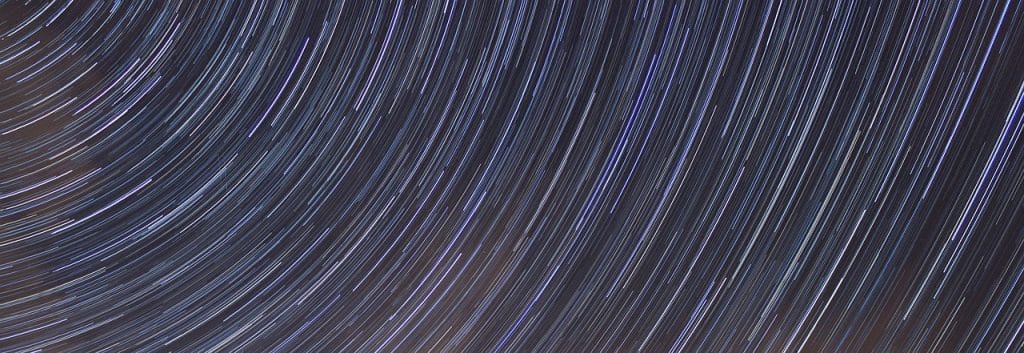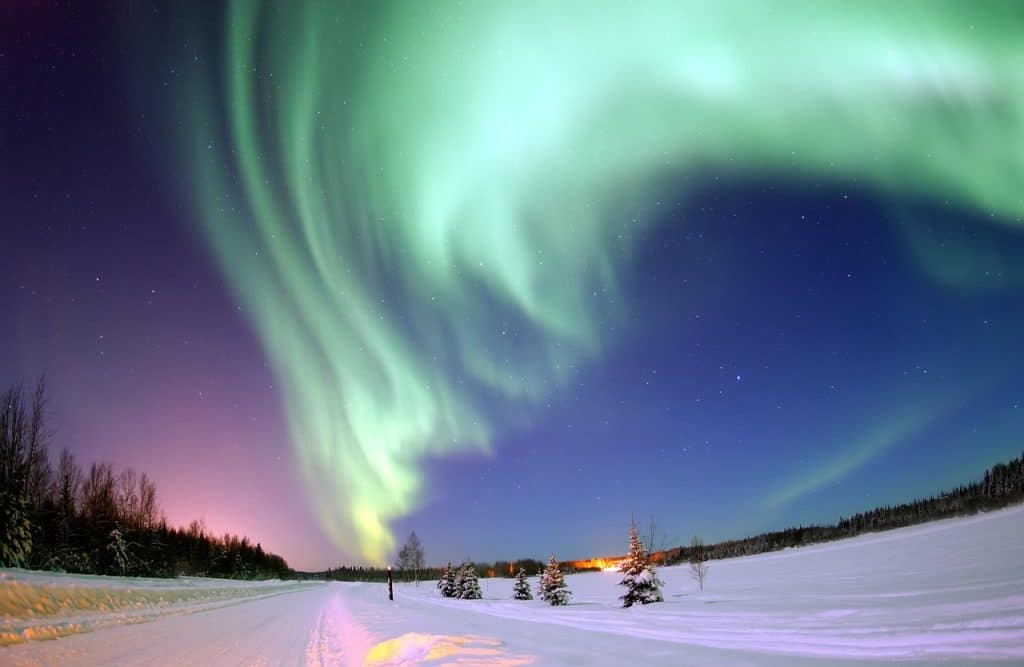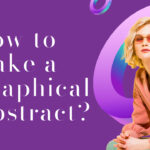Photographing the Night Sky With Simple Techniques
The night sky is erratic. Some nights are grey and overcast, while others are filled with stars and the movement of clouds on weather fronts.
Long shutter speeds are essential for capturing imaginative and beautiful nighttime images of the sky, so be patient and this type of photography will become second nature to you.
Star Trails

The light from stars appears to move in circles around the celestial pole due to the Earth’s rotation about its axis. After about 5 to 10 minutes, these movements are detectable and can be traced by your camera as a streak.
A sturdy tripod and a lot of patience are required to photograph this magical effect. Set the camera’s mode to Manual or Bulb and focus the lens to infinity. You can capture the stars moving across the sky by using a cable.
These exposures can last anywhere from a few minutes to several hours. You can make photographing star trails easier if you keep a few things in mind, such as timing, composition, and battery power.
Find the Right Location

Because cities have artificial lights, which cause a phenomenon known as light pollution, the best place to view and photograph the night sky is in the rural countryside.
To see the stars clearly, you must remove yourself from artificial lights. Although a truly dark sky is preferred, artificial lights prevent the night sky from being truly dark.
Many beginners strive to capture the longest star trails possible by leaving the shutter open for extended periods of time. They do, however, tend to underestimate the impact of ambient light in the sky, which can be difficult to notice at times.
Furthermore, residual light (such as moonlight) can have a disastrous effect on long shutter speed photos. This is because if you leave the shutter open for nearly 20 minutes, say, an hour after sunset, the camera may interpret it as a day shot.
Similarly, a full moon night photo with a 10 minute exposure time may appear to be a day shot. As a result, it is best to attempt such a photograph with a new moon, or well before or after the moonrise or moonset. The light from the stars would be more visible at this time, and the image would be perfect.
Note: If you want to make some adjustments to the photo just let me know. I can do it for you at a very low cost. You can hire me to edit your photo.
Use Long Shutter Speeds

Long exposures of 15 minutes or more will show the rotation of the Earth when photographing the night sky with a long exposure.
Of course, you’ll need a wide-angle lens and a sturdy tripod. You should use a cable release to eliminate camera shake, as it will RUIN your photo.
Set the camera to B “Bulb” shooting mode and focus the lens to infinity. Set your aperture between f/2.8 and f/4 for best results, then press the shutter release button on the remote. Because the sky is so dark and less prone to producing digital noise when the exposure is longer than 15 seconds, you should keep your ISO at 100 to keep digital noise to a minimum.
To complete the photo after your desired elapsed time, depress the remote again, and release the shutter.
Auroras and Polar Lights

Photographing the aurora borealis atmospheric phenomenon is a difficult task for photographers.
This difficulty is caused by the light’s frequent spectacular changes in brightness. The charged solar particles move very quickly and can sometimes become obscured, making it impossible to shoot them. However, if you follow these guidelines, you will be able to capture the best aurora borealis photographs.
To keep your camera steady for longer exposures, mount it on a sturdy tripod. Set the ISO to a value between 100 and 400. Depending on the amount of light available, the shutter speed can be as long as 30 seconds. Do not rely on the built-in light meter, which should only be used during the day.
Although any lens will suffice for aurora borealis photography, a wide-angle and faster lens is recommended.
Cloudy Skies
Take a look at the cloudy skies as the light fades. Look at the colors and how they blend through the clouds.
Even though it is dark, you should experiment with an 80A blue cooling filter to enhance the blue cast of the sky and reduce the yellow cast of artificial lights.
Opt for longer exposures and a wide-angle lens.
You can start by taking a few test shots and then carefully evaluating them on your digital camera.
You should be able to determine the best exposure range for capturing some good photographs of an overcast sky.

Recommended Settings
Metering after dark can be difficult, so make sure you select the best option for your specific situation.
For an accurate reading in both light and dark conditions, use spot metering. If the light is evenly distributed, you can use center-weighted or evaluative metering.
If possible, avoid using flash because it can have an effect on the resulting image, creating an over-lit area of the photograph.
Manual and Bulb modes are the best for this type of photography.
Recommended Equipment
A tripod should always be used when photographing the night sky.
Don’t forget to purchase a cable release or remote control to take the photograph – this is critical because some shots can take up to 30 seconds or more.
Your lens should ideally have an infinity focusing mode, and your camera should be capable of mirror lock-up – a feature in which the camera’s mirror moves out of the way before the shutter is released. This feature eliminates the vibration caused by the mirror slamming up against the camera housing.
For night skies, a wide-angle lens is the best option, and zoom makes it even more versatile.
Conclusion
When photographing the night sky, remember that patience is just as important as the ability to critically examine an image’s composition and decide what you need to change the next time to make it better.
As previously stated, determining the best exposure length for the image you want will be a trial and error process (in terms of lens length, shutter speed, aperture setting, as all three allow for different effects).
A cable release is required for long exposures of more than 30 seconds to ensure tack sharp final images. You might want to try a few B&W shots for more variety and possibly better photographs of stars in the sky.
If the weather is cold, dress warmly because sitting still on a cold night is much colder than walking in the cold, so extra layers may be required.
Take a flashlight with you so that you can adjust your camera in the dark.
The more images of the night sky you take, the better you will become at photographing them.
Note: If you want to make some adjustments to the photo just let me know. I can do it for you at a very low cost. You can hire me to edit your photo.
LATEST POST
- Google I O 2025 Top Web Updates
 What should you pay attention to during Google I/O 2025? Discover the announcements from the Google I/O event 2025, featuring Gemini 2.5 Pro, Beam 3D, AI Mode in Search, and Stitch.
What should you pay attention to during Google I/O 2025? Discover the announcements from the Google I/O event 2025, featuring Gemini 2.5 Pro, Beam 3D, AI Mode in Search, and Stitch. - Company Profile WritingUncover the essential components of a company profile. Our guide covers how to write about your mission, history, and contact details to showcase your business effectively.
- What is CashKaro and How to use CashKaro cashback app?Discover CashKaro and transform your online shopping! Learn how to earn cashback effortlessly with the CashKaro app. Start enjoying discounts today!
- How to Make a Graphical Abstract?Elevate your research presentation with our guide to crafting compelling graphical abstracts. Discover essential tips on visuals, clarity, and effective design.
- Best AI tools for Facebook AdsIf you’re seeking to improve your Facebook advertising strategies, Birch or Revealbot, AdEspresso by Hootsuite, and Zalster are exceptional AI tools that enhance efficiency and maximize ad performance.












